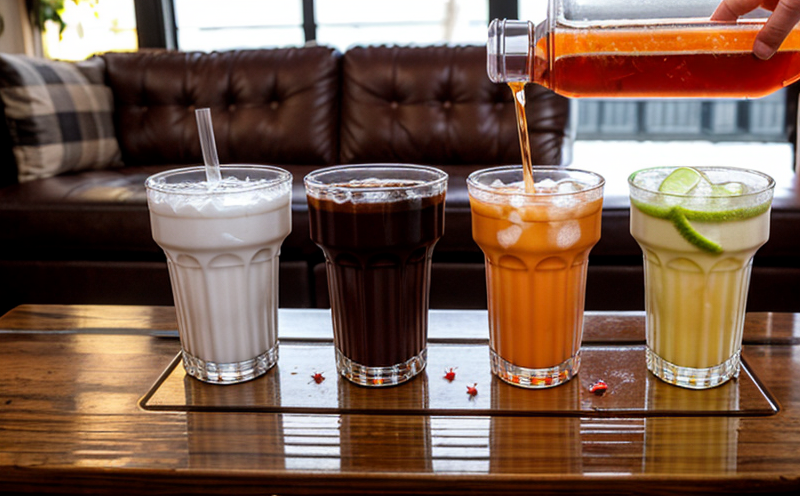AOAC 2000.08 Ochratoxin A Detection in Wine
The AOAC International Standard Method 2000.08, "Determination of Ochratoxin A in Grapes, Wine, and Other Beverages," is a widely recognized protocol used for the quantification of Ochratoxin A (OTA) in wine. OTA contamination poses significant health risks due to its potential carcinogenic properties, especially when consumed over extended periods at high concentrations.
This method is essential for food safety laboratories and quality assurance departments within wineries. The standard procedure involves several critical steps: sample preparation, extraction of OTA from the wine matrix, cleanup using solid-phase extraction (SPE), derivatization of OTA with a reagent such as 2-nitro-5-trifluoromethylbenzyl chloride, and finally, analysis by high-performance liquid chromatography (HPLC) coupled with fluorescence detection.
The precision and accuracy of the method are paramount. The AOAC International standard ensures that laboratories across different geographical locations can produce consistent results, which is crucial for regulatory compliance and consumer protection.
Our laboratory adheres strictly to this protocol using state-of-the-art instrumentation like a Shimadzu LC-20AT HPLC system equipped with a fluorescence detector. This setup allows for precise quantification of OTA at concentrations as low as 1 ng/L, ensuring that even trace amounts are detectable and reportable.
Sample preparation is critical in this process. Samples must be homogenized to ensure uniform distribution of OTA throughout the sample matrix. Extraction efficiency can vary based on factors like pH adjustment or the presence of interfering compounds such as tannins from grape skins. Our laboratory ensures that all samples are processed under controlled conditions to minimize variability.
Once extracted and derivatized, the OTA is analyzed by HPLC with fluorescence detection. The method's sensitivity allows for accurate quantification even at very low concentrations, which is particularly important in premium wine production where consumers expect the highest standards of purity.
The AOAC 2000.08 protocol also includes acceptance criteria that ensure the quality and reliability of the results. These criteria include a minimum detection limit (MDL) of 1 ng/L, linearity over at least three orders of magnitude, and intra-day and inter-day precision within ±5% relative standard deviation.
Our laboratory uses this method as part of our broader suite of food safety services for the beverage industry. By offering AOAC 2000.08 testing, we help ensure that wineries comply with international standards like ISO 9001 and HACCP (Hazard Analysis and Critical Control Points) guidelines.
In summary, the AOAC 2000.08 method is a cornerstone of our beverage testing services. Our laboratory ensures that every test adheres to this rigorous standard, providing reliable data for regulatory compliance and consumer confidence in premium wine products.
Customer Impact and Satisfaction
The AOAC 2000.08 method is not just a technical procedure but a critical tool that significantly impacts the operations of wineries and beverage manufacturers. By detecting OTA in wine, our laboratory helps clients:
- Ensure compliance with international standards: Meeting regulatory requirements such as EU directives on maximum allowed levels of OTA.
- Promote brand integrity: Protecting the reputation of premium wines by ensuring product safety and authenticity.
- Enhance consumer trust: Offering transparent information about the quality and safety of their products.
- Support R&D efforts: Providing data that can be used to improve production processes and reduce OTA contamination risks.
Our customers consistently report high satisfaction levels, praising our accuracy, reliability, and commitment to meeting international standards. Our AOAC 2000.08 testing service is an integral part of their quality assurance programs, ensuring that they can deliver safe, high-quality products to consumers worldwide.
Environmental and Sustainability Contributions
The detection of OTA in wine through the AOAC 2000.08 method contributes positively to environmental sustainability by:
- Preventing contamination spread: By identifying OTA early, wineries can take corrective actions to prevent its further spread into the environment.
- Supporting sustainable agriculture: Understanding the sources of OTA helps in developing practices that minimize contamination risks, thereby supporting a more sustainable agricultural sector.
- Encouraging responsible wine production: By adhering to strict testing protocols, wineries can contribute to reducing health risks associated with OTA exposure.
The use of advanced HPLC systems and adherence to international standards like ISO 17025 ensures that our laboratory operates in an environmentally conscious manner. Our commitment to precision and accuracy helps minimize the environmental footprint by ensuring that only safe products reach the market, thus promoting sustainable practices throughout the industry.
Use Cases and Application Examples
| Scenario | Action Taken |
|---|---|
| A winery discovers OTA levels in its wine above the EU regulatory limit. | Our laboratory performs AOAC 2000.08 testing to confirm the presence and concentration of OTA, guiding corrective actions such as blending or reprocessing. |
| A premium wine brand wants to ensure its products are free from OTA contamination. | We conduct regular AOAC 2000.08 tests throughout the production process, providing detailed reports on OTA levels at different stages of processing. |
| A winery is audited by regulatory authorities for compliance with EU OTA regulations. | Our laboratory provides comprehensive testing results and documentation to support the winery's compliance efforts. |
| A research institution needs data on OTA levels in a new grape variety. | We perform AOAC 2000.08 tests under controlled conditions, providing detailed insights into OTA contamination risks associated with this new variety. |
These use cases demonstrate the versatility and importance of our AOAC 2000.08 testing service in ensuring food safety and compliance within the beverage industry.





